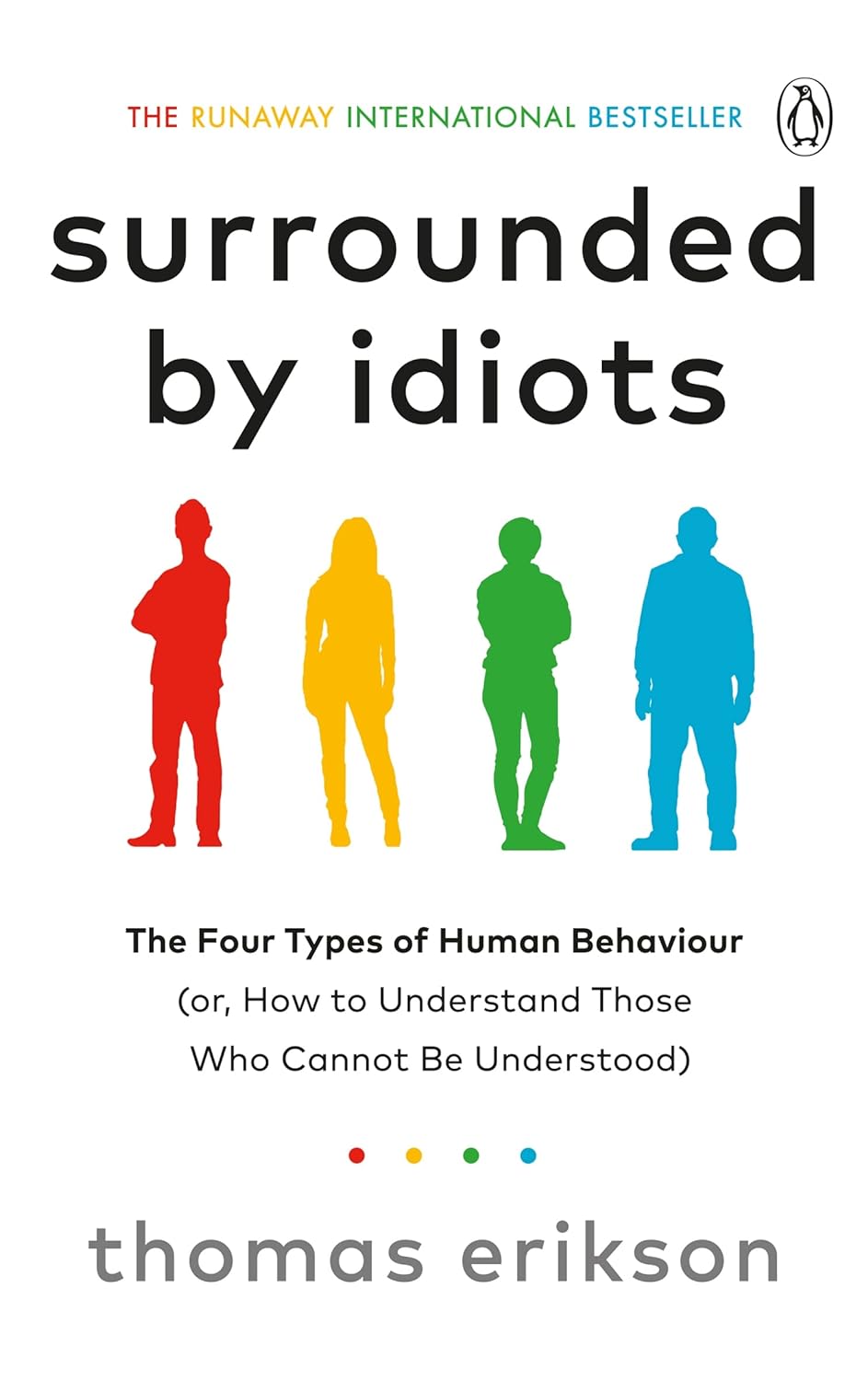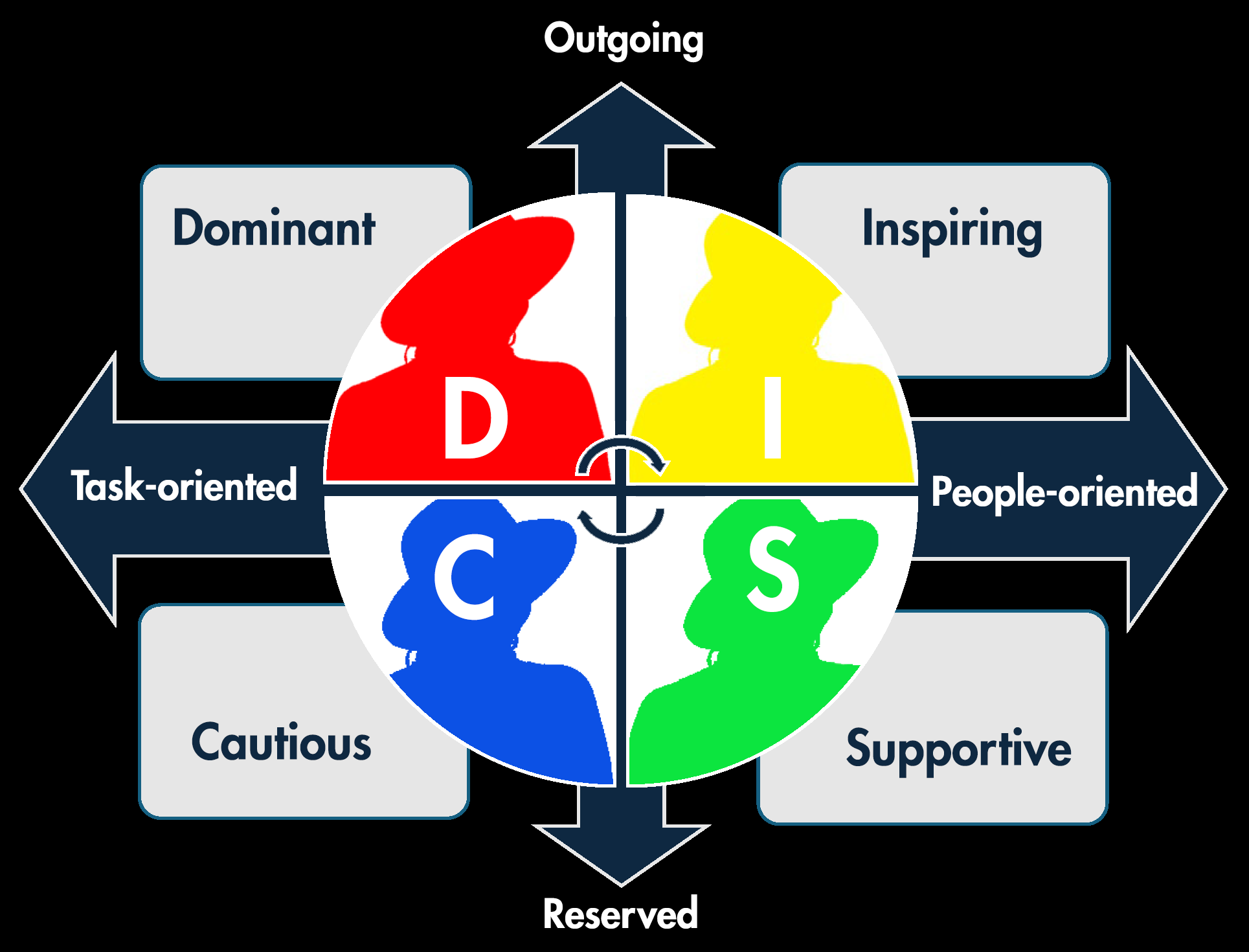


How Swedes were fooled by one of the biggest scientific bluffs of our time
Dan Katz, licensed psychologist and psychotherapist, explains why Thomas Erikson’s success with his book Surrounded by Idiots is one of the biggest pseudoscience scandals in recent history.
Over the last few years, hundreds of thousands of Swedes have spent an estimated total of more than ten million euros on a book which many of them believed contained a scientific account of human psychology, written by an expert in the area. The book’s success has led many companies and other organizations to order personality tests, from a growing number of suppliers eager to exploit the new market, and apply them on their employees. Surrounded by Idiots has had a major impact on how Swedish people talk to each other about psychology and discuss the behaviour of those around them. Indeed, Thomas Erikson has undoubtedly had the greatest influence on the public’s interest in psychology in a generation.
Unfortunately, the theory behind this book, and the various follow-ups, is no more than pseudoscientific nonsense. And Erikson appears to lack even basic knowledge of psychology or behavioural science. This is why we at VoF (Vetenskap och Folkbildning – the Swedish Skeptics Association) named Thomas Erikson Fraudster of the Year in 2018.
Accusing an individual of being a fraud should never be done lightly. We need to be very sure of where we stand. Here I lay out the case as to how and why Thomas Erikson books have misled so many people…
★ ★ ★
Suddenly, you saw it everywhere. Large posters, hanging behind piled up books at the entrance to book shops, showed images of four people, shaded red, blue, green and yellow. You couldn’t miss them. They were especially prominent in airports, and as you boarded the plane it wasn’t unusual to walk past rows of seated passengers, already engrossed in the book with those four colourful figures on the front cover.
Around the same time, qualified psychologists began reporting how clients were considering leaving their partners because, “I can’t possibly live with a yellow person”.

Or, that they had been tested at the Human Resources department only to be told they needed to move to another team because their “colour combination” in their current team wasn’t working.
A teenage girl comes home and tells her mother, with an air of resignation, “Mum, I’m green.” She had been tested by her school counsellor.
In cafés the same discussions could be heard again and again “I am red and a little blue. What colour are you? I’m sure that you are yellow!”
Around the same time, Thomas Erikson started to appear in the media. He presented himself as an expert in behaviour and communication, appearing in this role on the morning news at the Swedish national TV channel, TV4. When his follow-up book, Surrounded by Psychopaths, was published, state broadcaster, SVT, invited him on the show “Ask a Doctor” to talk about psychopaths. A leading newspaper, Aftonbladet, gave him a weekly column where he would answer questions about psychology. Lectures sold out across the country, despite high ticket prices, and Erikson would use them to explain how humanity could be divided in to red, yellow, blue and green personality types. Never before had one person had such a big impact on the general publics’ understanding of how and why people behave the way they do.
Psychologists were scratching their heads. How had the Swedish nation become so infatuated with Erikson and his four colours? Some professionals recognised talk of colours from the infamous Myers-Briggs test, administered by less-respectable management consultants. It built on the mystical ideas of the Swiss psychoanalyst Carl Jung, active at the start of the 20th century, whose theories are now mostly of historical interest. The theory of Myers-Briggs was not something modern psychologists took seriously. Since the test had been developed quite some time ago it had been the subject of extensive research and the results had revealed serious flaws.
Despite the use of colours, it turned out that the ‘Surrounded by …‘ books were not based on Myers-Briggs. Instead, they built on another personality theory, the so-called DiSC model. The most noteworthy outcome of a search through the academic literature on this model was that, despite the fact that the test had been around for fifty years, there was in principle no research on whether or not it worked.
To get to the bottom of Erikson’s theory of colours, and how large parts of the Swedish population came to take it seriously, we need to look at what science can really say about personality, what we currently know about personality tests, and the ways in which the public and mass media can be fooled by pseudoscientific theories of personality. And we need to take a closer look on who Thomas Erikson really is.

Personality isn’t an explanation
Before we define personality, it is useful to explain what it isn’t. Consider a friend who does something bad and then says, “I did it because my personality led me to do it”. In making this argument, our friend is essentially claiming that their personality is like a Gremlin in their head who steers their behaviour, telling them what to do. In reality, of course, the Gremlin doesn’t exist and we don’t usually accept this argument as an excuse for bad behaviour.
Instead of invoking Gremlins, the most reasonable and widely accepted definition of personality is behaviour of an individual which is relatively constant over time and doesn’t depend on context (Perugni et al, 2016). Personality isn’t a thing, like a Gremlin, it is simply a pattern of repeatable behaviour. Using this definition, the Gremlin argument becomes circular: if someone claims that their personality made them do something, we can simply counter, “Well, yes, that is the definition of personality. All you are telling me is that you behaved in the way you did because you behaved the way you did.”
The invocation of a personality Gremlin is one example of careless thinking. Other similar mistakes are harder to spot. For example, consider a person who says, “Now I understand why I have such negative thoughts, can’t get to sleep, and have difficulty getting going… I’ve got a depression.” This person might believe that the explanation of her symptoms is depression, but in fact, the diagnosis of depression is just a categorisation of exactly these symptoms. There is no depression Gremlin, either.
Popular psychology is often apt to make this type of mistake. About ten years ago, Mia Törnblom – a very popular Swedish motivational speaker – made a small fortune selling books about how we can improve our self-confidence. She reasoned that that negative thoughts arise from having a low self-confidence. But having negative thoughts of oneself is exactly the definition of low self-confidence and leads to circular thinking: low self-confidence is explained by low self-confidence.
This mistake gets worse if ‘low self-confidence‘ is turned into a Gremlin, as Törnblom could be said to do in her writing. She suggested that people with low self-confidence should look in the mirror and repeat the phrase “I am fantastic” over and over again. The idea is that doing this exercise would ‘encourage’ our self-confidence and allow us to do things, like talking in front of an audience, that we had previously been scared to do.
For people with negative thoughts about themselves, this type of “positive affirmation” has actually been shown to be counterproductive (Wood et al. 2009). Negative thoughts and nervousness increase when these exercises are performed. This is a clear example of how well-meaning advice from someone without education and experience in psychology can lead to negative outcomes. Practicing psychologists are still asked by clients to ‘cure’ their confidence problems in this way. If only it was as simple as repeating a mantra…
In summary, terms like ‘depression‘ or ‘low-self-confidence‘ are useful labels, but they are not explanations. Using them as such is akin to saying that bad weather causes it to rain. So even if we could identify people as red, blue, green and yellow types then the colours wouldn’t explain anything.

Credit: Woodcut circa 1610 Iconologia.
CC BY 4.0
We do have different personalities, though, don’t we?
Modern evidence-based methods in behavioural science adopt the ground principle that people’s behaviour mainly depend on context. A child might be shy among her classmates at school, but suddenly take a central role when surrounded by friends in her football team. An outgoing person can quieten when he realises that no-one is paying him any attention. These basic facts, which we are all aware of, mean that psychologists are very careful when using the term personality.
Accepting these limitations, there have been many scientific attempts to classify different personality types. These stretch from over two thousand years ago, when Hippocrates, classified four types of temperament (sanguine, choleric, melancholic, and phlegmatic) to the work of Carl Jung at the beginning of the twentieth century. But it wasn’t until the 1980’s and 90’s and the model that is now known as ‘The Big Five‘ that these attempts became grounded in a proper scientific framework.
‘The Big Five‘ didn’t come from a theory but through statistical analysis of thousands of personality questionnaires consisting of hundreds of questions. These reveal five properties that are relatively constant over time: Openness, Conscientiousness, Extraversion, Agreeableness and Neuroticism. These don’t classify people as distinct types – people can range from being very agreeable to very disagreeable with the vast majority lying somewhere near to the middle – and the properties are not mutually exclusive – very open people can also be conscientious.
In summary, ‘The Big Five‘ is a useful way of summarizing statistical differences in human behavior, but even the psychologists who developed these tests are very careful when classifying people according to them (Sjöberg, 2010). Yes, we do have different tendencies in how we behave, but they are only a small part of explaining who we are.
Is there a scientific basis for the colour theory in Surrounded by Idiots?
The back cover of Eriksons’s book claims that “using a scientific background […] this book gives a concrete way of understanding the most important differences between different communication styles”. So what exactly is this supposed scientific background?
Almost the only ‘scientific‘ reference that Erikson provides in his book is from a book written in 1928 called The Emotions of Normal People, by American psychologist William Moulton Marston. Moulton hypothesised that our behaviour is influenced by ‘psychonic energy‘ that is transferred through a web of nerve cells that he called ‘psychons‘. The four personality types (yellow, green, blue and red) arise, Marston claims, as variations between different people in the structure of their psychonic network.

This ‘theory‘ is pure speculation on the part of Marston. There was no scientific evidence for psychons or psychonic energy in 1928 and there is none today. At the time of publication, the science of psychology was in its infancy and, like Hippocrates and Jung before him, he had created a theory without proper scientific grounding. Unlike Hippocrates and Jung though, Marston’s theory garnered little attention, and he left psychology. He later rose to fame though when he created the comic book hero Wonder Woman!
There was however one person who followed up on Marston’s writings. In 1956 Walter Clark decided to invent a personality test based on the four-colour model. This test was further developed and is now called the DiSC model. It was later marketed as a tool for businesses to understand their employees. According to the DiSC test, humanity can be divided in to four basic types:

- Red: dominant, driven, solution focused.
- Blue: analytic, careful, meticulous
- Green: patient, considerate, nice
- Yellow: extroverted, creative, verbal
This is all very well, but despite the fact that this test has existed for over fifty years and is quite widely spread there is no scientific study published about it. Even according to the test’s representative in Sweden, the Institute for personal development or IPU, no scientific articles have been published about the test. This means we have no way of knowing if people give consistent answers to the questions over weeks or months. Nor do we have any way of knowing if, for example, a person who answers indicate they are red are in fact dominant or driven.
Erikson’s description of his own results in the test are, at best, contradictory. He says, “People can be many colours!”. He later claims, without any evidence, that “80% have two colours!”. And about himself he says, “I have three colours: red, blue and yellow!”. Given the stated aim of the test to classify personalities, such claims are bizarre. Indeed, by studying in more detail what the colours are meant to say about a person, my colleague Urban Fagerholm, found that Erikson must, based on his own claims, be both fast and slow in his reactions; both maximally and minimally interested in relations; and both careful and impulsive. Moreover, his lack of greenness implies that Erikson lacks patience, calm, stability, kindness and many other basic characteristics!
In summary, the four-colour model is based on a theory that has no scientific basis, has been subject to no rigorous testing and gives confusing and contradictory results. It is, quite simply, pseudoscience.
How does a colour theory effect workplace communication and conflicts?
Erikson has repeatedly claimed that the benefit of his colour approach is that it helps us understand ourselves and others and, as a result, improves our communication and reduces conflicts. This is his argument as to why companies and organisations should adopt his approach. Since there is no scientific support for the four colours, there is naturally no support for this claim either. It is however useful to consider what might happen, based on research, were his colour theory to be applied.
A common mistake when problems occur within an organisation is to focus on the individuals that are involved in conflicts. In fact, since it is the context of a situation which decides how people act, the primary concern in addressing any conflict should lie in how the organisation works. Before an organisation consultant, brought in to resolve conflicts, looks at individuals she should look at the structure (Olofsson & Nilsson, 2015). How are decisions taken? And how are employees informed of decisions made? How is responsibility shared? Which behaviour is rewarded or punished and in what ways?
It is, unfortunately, often the case that companies send ‘defective’ employees away to learn ’how to handle stress’, when in fact the stress is a completely reasonable response to the structural problems in an organisation. This is another example of the circular argument we described above, where the stressed employee is identified as the cause of the problem, her mythical Gremlin is to be exorcized.

Photo by Allen Taylor on Unsplash
If Erikson’s personality theory did work (which it doesn’t), then it would encourage this type of mistake: someone who acts in a certain way would be seen in terms of their colour and the reasons for any problems would be ignored. It is difficult to imagine a more unpleasant and unfair way of dealing with a problem than simply attributing it to the fact that the person in the centre of a conflict ’is blue’. Naturally, some problems can arise through personal conflicts both in the workplace and within the family, but the solution is communication between all parities, not a reliance on personality theories.
Maybe the only positive thing that can be said about Erikson’s theory is that it might help some people realise that not everyone thinks the same way they do. Psychologists call this ’theory of mind’, an ability to change perspective, which usually develops in early childhood. In other words, Erikson’s book might help someone with the empathetic and intellectual level of a five-year-old.
Is Erikson an authority in behavioural science?
In the translation of his books from Swedish to other languages, Erikson is described as a behavioural scientist. In interviews he calls himself a ’behavioural expert’ and ’expert in communication’.
When myself and my colleagues started this investigation, the first thing we did was try to establish his academic and professional credentials. We contacted his company Team Communications and after three emails we received an answer from Christina who first said that she “didn’t understand” the question about his education, then later said that Thomas Erikson would answer himself “when he has time”. An answer never came.
It turned out that Christina was in fact Erikson’s wife, which only served to increase our interest. So, we used Ladok, the register of everyone who has studied at Swedish colleges and university, to see if we could find the courses taken by Erikson. There was no-one with his name and birthdate registered. In fact, Erikson’s professional background is in sales, first for the bank Nordea and then running his own business training salespeople. It is most likely that his only educational background is, at best, the Swedish equivalent of a high school diploma.
According to Sune Gellberg, the owner of IPU, the organisation in Sweden which sell the DiSC test, no qualifications are required to carry out personality tests. “I don’t know what education our consultants have because it doesn’t matter”, he told us, “It is a computer program that does the personality analysis and gives the consultant a report which he can go through with the respondent.”
Not even the representative for the test thinks that knowledge of psychology is important! Personality consultants have no education in test methodology and no knowledge of personality theory. They just feed in numbers to a computer and have no idea what the results mean or what their scientific value is. It is very possible that Erikson believes that the test has scientific grounds and, given his lack of education, it is very likely that he has no idea what it actually says.

To try to find out more, in September 2017, we went to one of Erikson’s sold out lectures at the Rival theatre in Stockholm. The presentation was, for anyone with a basic education in psychology, embarrassing. He started by placing Freud and Jung as the grounders of modern psychology, a distinction that even someone who has studied a four-week course in the area will know is incorrect. The subject has developed greatly since the time of Freud, Jung and comic book author Marston.
Both in that lecture, and later in radio interviews, Erikson attempts to explain that behaviour and personality are different. He claims that “personality lies a lot deeper”. This presentation appears to invoke the Gremlin we met earlier, who controls who we are. Considering that Erikson has no education at all in the behavioural sciences, this is a very understandable mistake. But it contradicts the very logic of modern psychology, which defines personality as repeatable behaviour. Gremlins have no scientific basis.
Did Erikson deliberately overstate his qualifications?
When faced with challenges to his work, Erikson claims that we are attempting to make out that his readers are idiots. Nothing could be further from the truth. We believe that the books have been falsely marketed, and that readers have been misled to believe that Erikson has a scientific background and that his books are based on research.
Despite a lack of any qualification, Erikson describes himself as a behavioural scientist. Before the publication of one of the first articles, in Swedish magazine Filter, questioning the validity of the Surrounded by Idiots book, Erikson e-mailed me (we both shared the same international agent, so we had met briefly once before) and asked whether, given my own profession as a psychologist and my position as a board member of the Swedish Skeptics Association, I would support his claim that he was a ‘behavioural scientist’. I declined to offer such support, despite the fact that from a legal point of view in Sweden, it is possible to call yourself a ‘behavioural scientist’ without any formal qualifications. He has just as much right as my poodle to call himself a behavioural scientist.

Photo by Tra Tran on Unsplash
Nevertheless, Erikson did tell Filter that I had supported his right to use the title, a falsehood that was very easily revealed by the Filter journalist who phoned me up to double check the claim. On his homepage Erikson claimed that “in an interview with Filter I referred to a psychologist who supported my claim [to be a behavioural scientist]”. This is simply untrue. In the question of his qualifications, as with the reasoning within his books, Erikson appears to fool himself in to believing that he is in the right.
Overstated qualifications aside, the question remains as why so many people bought the book, even as suspicions were raised about its validity. Part of the explanation can lie in genuine psychological phenomena. For example, the popularity of the book could be the result of a snowball effect, where people talking about the book increased interest and others bought it because others were talking about it. Another is the ’sunk cost’ effect, whereby people who have bought the book, spent time reading it and maybe telling their friends about it, don’t want to lose face by admitting that they got it wrong.
Then comes the question of where responsibility lies. The first version of the book was published by Hoi publishing, who help authors to self-publish. But as sales grew, it was Forum, part of Sweden’s biggest media concern Bonnier, who won the auction to buy the book and publish it for a wider audience. While Hoi may be forgiven for not checking the factual basis for a book, it is difficult to fathom that a large publisher like Forum could publish without factchecking or assessing the author’s background.
The same questions can be raised of TV4, SVT and Aftonbladet, who used Erikson in his role as a behavioural expert. In the case of Aftonbladet, they asked Erikson to write a column even after the magazine Filter called into question his expertise. When we at VoF named Erikson’s “Fraudster of the Year” it received some attention in the national press, but was ignored by Aftonbladet. Up to that point, we can only imagine that each media outlet saw that others, including Bonnier, had accepted the book’s validity and assumed that it was scientifically sound.
Our society builds on trust. We assume that people who write books understand the area they are writing about. We trust respectable book publishers. We assume newspapers editors check facts and sources. We believe in public service television and radio.
It is here we confront the biggest problem of all. In the age when anyone can publish their views online, the very institutions which we are meant to trust – publishers, broadcasters and newspaper editors – have to fight harder than ever to maintain their own trustworthiness. If they lose that trust, then the very existence of democracy and the open society is at risk. For all of us: blue, red, yellow, lilac or green.
– Dan Katz
Epilogue, January 2020
Since this article was published in spring 2019, Erikson’s book has been sold to over 35 countries. In Norway, it was last year’s all-round bestseller. Forbes had his book on a top-ten “must read” list. The estimated sales around the world is now 2.000.000 copies. And on amazon.com, his publisher is still presenting him as “behavioural scientist”.
★ ★ ★
Nota bene
The original article was published in the Swedish Skeptics Association’s (VoF) publication Folkvett #1 2019, in close proximity to Erikson receiving Fraudster of the Year Award 2018. This version of the article was translated into English and edited by David Sumpter, professor of mathematics at Uppsala University, in January 2020. The article was further updated and edited by Lotten Kalenius, VoF Chairman of the Board, in April 2024.
★ ★ ★
References
- Anastasi, A., Urbina, S. (1997) Psychological Testing, 7th ed..Prentice Hall, Upper Saddle River
- Cioffi, F. (1970) Freud and the Idea of a PseudoScience
- Blom, J. H. (2018) ”Vad du bör vara medveten om när du läser Omgiven av Idioter och kategoriserar människor i fyra färger”, jonashjalmarblom.com, 11 April 2018 (Wayback Machine snapshot 4 January 2019)
- Borger, R. & Cioffi, F. (eds) Explanation in the Behavioural Sciences, 471-499. Cambridge: Cambridge University Press
- Cioffi, F. (1998) Freud and the Question of Pseudoscience. Chicago: Open Court.
- Email (3 April 2017) between Dan Katz and Christina Granbom (Team Communication)
- Email (23 April 2017) between Dan Katz and Sune Gellberg (IPU)
- Email (24 June 2018) between Dan Katz and Thomas Erikson
- Erikson, T. (2014) Omgiven av idioter. Hoi förlag, Stockholm
- Erikson, T. (2018) ”Med anledning av publiceringen i Magasinet Filter 17 juli 2018”, thomaserikson.com/Surrounded by Idiots, 26 July 2018 (Wayback Machine snapshot 25 February 2021)
- Erikson, T. (2019) ”Med anledning av kritik gällande DISC metoden”, thomaserikson.com/Surrounded by Idiots, 15 January 2019 (Wayback Machine snapshot 3 March 2021)
- Jones, E. E.; Harris, V. A. (1967). ”The attribution of attitudes”. Journal of Experimental Social Psychology. 3 (1): 1–24.
- Kahneman, D. (2012) Thinking Fast and Slow, Penguin Books, London
- Katz, D. (2019) ”Om 2018 års pris till ’årets förvillare'”, Folkvett no. 1
- Katz, D. (2017). Ödlan i huvudet, KBT i bilder, illustrerade metaforer för ett rikare liv. KBTakademin, Västerås.
- Lilienfeld, S.J. Lynn, & J.M. Lohr (Eds.), Science and pseudosci- ence in clinical psychology (pp. 205–239). New York: Guilford
- Lilienfeld et al (2007) Perspectives on Psychological Science, March 1, 2007 vol. 2 no. 1 53-70.
- Lundberg, M. (2018) ”Omgiven av fyra färger – bara för färgblinda?”, Lundberg Media/My Newsdesk, 29 July – 12 August 2018
- Murphy Paul, A. (2004) The Cult of Personality Testing. Free Press N.Y. New York.
- Olofsson, R,. Nilsson, K. (2015) OBM I praktiken: förändra beteenden och nå resultat I organisationer. Natur & Kultur, Stockholm
- Perugni, M., Costantini, G., Hughes, S., de Houwer, J. (2016). ”A functional perspective on personality”, International Journal of Psychology, Vol. 51, No. 1, 33–39
- Pollnow, M. (2018) Magasinet Filter, ”Omgiven av idioti”, 16 July 2018 no. 63.
- Ramnerö, J. & Törneke, N. (2006). Beteendets ABC. Studentlitteratur, Stockholm.
- Sjöberg, L. (2010) Personlighetsdimensioners validitet i arbetslivet: teorier och empiri. Center for Risk Research and Center for Media and Economic Psychology Marketing and Strategy Department, 2010:6 Stockholm School of Economics, Stockholm
- Sjöberg, S. (2014) Utilizing research in the practice of personnel selection. Stockholms Universitet, Stockholm.
- Stiftelsen för tillämpad psykologi, STP (2004). Granskningsrapport Thomas Systemet Personlig Profil Analys
- Thomas PPA. Witkowski & Zatonski (2015) Psychology Gone Wrong: The Dark Sides of Science and Therapy. Brown Walker, Boca Raton
- Wood, J. V., Perunovic, W. Q. E., & Lee, J. (2009). ”Positive thinking: Power for some, peril for others”, Psychological Science, 20, 860866
Skeptisk måndag med VoF Varje måndag publicerar vi ett blogginlägg om ett ämne som berör våra intresseområden, dvs vetenskap, pseudovetenskap, myter, konspirationsteorier eller skeptikerrörelsen som sådan.
Fully agree with your text. This book is a catastrophy and shall be forbidden! Not only that the DISC test is very critical. At the same time, he is writing the most negative things about greens – with the peaks the interviews and the questionnaire. They seem to be useless!!!! This booj is a crime!!! And shall be forbidden.
Tack sa mycket for this comprehensive write-up. I landed here while researching a company that moved into the office building where I work (in the US), that apparently trains people to ”consult” with businesses to apply personality tests based on DiSC tests. Their vague and somewhat cult-ish promo material made me suspicious. Apparently rightly so.